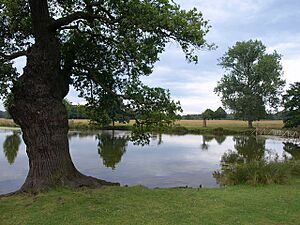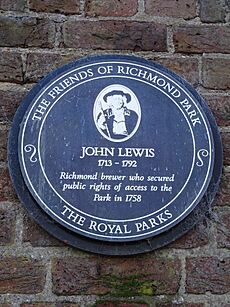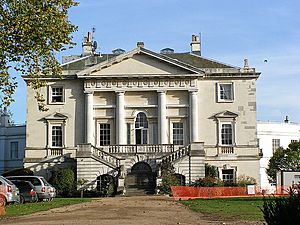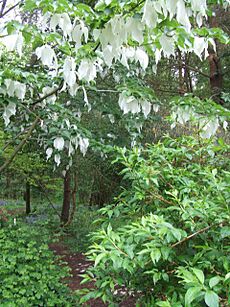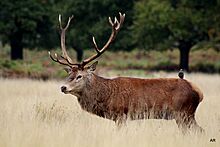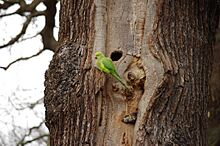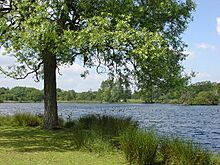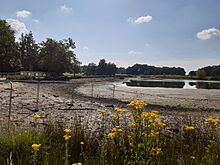Richmond Park facts for kids
| Site of Special Scientific Interest | |
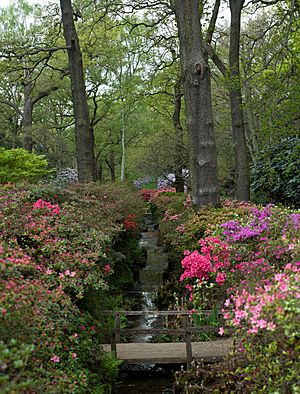
Isabella Plantation, Richmond Park
|
|
| Area of Search | Greater London, England, United Kingdom |
|---|---|
| Grid reference | TQ2073 |
| Interest | Biological, historical |
| Area | 2360 acres (955 hectares) |
| Notification | 1992 |
| Location map | Magic Map |
Richmond Park is London's biggest Royal Park. It is located in the London Borough of Richmond upon Thames. This park is super important for wildlife and nature conservation, not just in the UK but around the world!
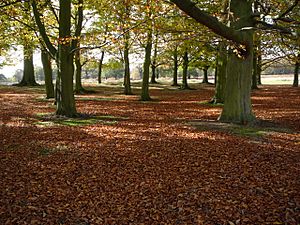


King Charles I created the park in the 1600s as a place to hunt deer. Today, it's a special nature reserve and a Site of Special Scientific Interest. It's also listed as a Grade I historic park, meaning it's very important for its history and beautiful landscapes. Many famous artists have been inspired by its views, and it has even been a filming location for movies and TV shows!
Richmond Park has many interesting old buildings. White Lodge, a Grade I listed building, used to be a royal home. Now, it's where the Royal Ballet School trains young dancers. Other buildings, like Pembroke Lodge, are also historic. Pembroke Lodge was once home to a former British Prime Minister, Lord John Russell, and his grandson, the famous thinker Bertrand Russell. In 2020, two ancient mounds in the park, possibly old burial sites, were also given special historic protection.
Even though it was once just for the king, Richmond Park is now open for everyone to enjoy. You can find a golf course and other sports facilities here. The park also played a role in both world wars and hosted events for the 1948 and 2012 Summer Olympics.
About Richmond Park
How Big is Richmond Park?
Richmond Park is the largest of London's Royal Parks. It covers a huge area of 955 hectares (2,360 acres). This makes it the second-largest park in London overall. It's also Britain's second-largest walled urban park.
| Park Name | City | Area | Notes | |
|---|---|---|---|---|
| Hectares | Acres | |||
| Richmond Park | London | 955 | 2,360 | |
| Bois de Vincennes | Paris | 995 | 2,458 | |
| Bois de Boulogne | Paris | 846 | 2,090 | |
| Casa de Campo | Madrid | 1750 | 4,324 | |
| Central Park | New York City | 341 | 843 | |
Special Status of the Park
Richmond Park is very important for wildlife. Most of the park is a Site of Special Scientific Interest (SSSI), a National Nature Reserve (NNR), and a Special Area of Conservation (SAC).
It became an SSSI in 1992 because it has been a royal deer park for centuries. This has created many different habitats for wildlife. The park is especially known for its ancient trees and the rare beetles that live in their decaying wood. It also has the largest area of dry grassland in Greater London.
In 2005, it was named an SAC because of its many old trees with rotting wood. This is a perfect home for stag beetles and other insects that depend on decaying wood.
Since 1987, the park has been listed as a Grade I historic park. This means it's recognized for its history as a royal deer park since the 1600s. It has been open to the public since the mid-1800s.
Where is Richmond Park?
Richmond Park is in the London Borough of Richmond upon Thames. It's close to several towns and areas like Richmond, Ham, Petersham, Kingston upon Thames, Wimbledon, Roehampton and East Sheen.
 |
Richmond | East Sheen, Mortlake | Roehampton |  |
| Petersham, Ham | Wimbledon Common | |||
| Kingston upon Thames | Kingston upon Thames | Coombe, Kingston Vale |
How the Park is Managed
Who Manages the Park?
The Secretary of State for Culture, Media and Sport is in charge of Richmond Park and other Royal Parks of London. This power comes from a law passed in 1851. The day-to-day management of the parks is handled by The Royal Parks, a special government agency.
Local groups, like The Friends of Richmond Park, also work together to discuss park issues. They make sure that the park is well looked after for everyone.
Visiting Richmond Park
Richmond Park is the most visited Royal Park outside central London. In 2014, it had 4.4 million visitors!
The park is surrounded by a tall wall with several gates. Some gates are just for people walking or cycling. Other gates allow cars, but only during daylight hours. The speed limit for cars is 20 miles per hour. Pedestrian and cyclist gates are open 24 hours a day, except during deer culling seasons in February and November. Since 2020, there have been limits on cars driving through certain parts of the park on weekends.
A free bus service runs from April to November on Mondays, Wednesdays, and Fridays. It stops at the main car parks and near the Isabella Plantation.

Gates open to cars include Sheen Gate, Richmond Gate, Ham Gate, Kingston Gate, and Roehampton Gate. Chohole Gate is only for the golf course.
The park has special paths for horses (bridleways) and cycle paths. These are shown on maps at the entrances. Horse bridleways are only for horses, not cyclists.
You can walk along the Beverley Brook Walk and the Capital Ring walking route through the park. Cycling is allowed on main roads and on the Tamsin Trail, a path for both walkers and cyclists that goes around the park's edge.
Because the park is a nature reserve, dog owners must keep their dogs under control. This means not letting them bother other visitors or wildlife. It's also advised not to walk dogs in the park during the deer's birthing season.
Park Rules and Safety
In 1854, a robbery in the park led to the creation of a special park police force. Today, the park is policed by the Metropolitan Police.
Police can give on-the-spot fines for littering, cycling outside marked areas, and dog fouling. For example, in 2012, a dog owner was fined for letting five dogs chase ducks. Since 2013, professional dog walkers need licenses and can only walk four dogs at a time. Cyclists have also been fined for speeding in the park.
In 2021, a politician was fined after his puppy caused a deer stampede. He apologized and promised to be more careful.
Sports and Fun Activities
Richmond Park offers many ways to stay active:
- Cycling: You can rent bikes near Roehampton Gate. The Tamsin Trail is a great car-free path for cycling around the park.
- Fishing: Fishing is allowed on Pen Ponds from mid-June to mid-March if you have a permit.
- Golf: The Richmond Park Golf Course has two 18-hole courses. It was opened in 1923 by the Prince of Wales.
- Horse Riding: Horses from local stables often ride in the park.
- Rugby: In winter, part of the park is set up for rugby games.
- Running: The Tamsin Trail, about 7.2 miles (11.6 km) long, is popular with runners. There's also a weekly 5-kilometer run called Richmond Park Parkrun every Saturday.
There's also a children's playground at Petersham Gate.
Friends of Richmond Park
 |
|
| Abbreviation | FRP |
|---|---|
| Formation | 1961 |
| Legal status | registered charity and membership organisation |
| Purpose | To conserve and protect Richmond Park and its peace and natural beauty for the benefit of the public and future generations, and to advance public education about the park |
| Headquarters | Richmond, London |
| Location |
|
|
Membership
|
3,700 |
|
Key people
|
Roger Hillyer, Chairman |
|
Main organ
|
Park Life (printed magazine, published twice a year) |
|
Staff
|
None |
|
Volunteers
|
300 |
The Friends of Richmond Park (FRP) is a group founded in 1961 to protect the park. They work to keep the park peaceful and beautiful for everyone.
In the past, they successfully campaigned against plans to turn park roads into main highways. They also helped reduce the speed limit in the park.
The Friends helped fund a new Jubilee Pond and started a program to restore streams and ponds in the park. They run a visitor center, organize walks, and offer educational activities for young people. They also publish books about the park, with profits going towards conservation.
The Friends of Richmond Park is a charity with 3,700 members and about 300 volunteers. Famous people like Sir David Attenborough are patrons of the group.
History of Richmond Park
How the Park Started
In 1625, King Charles I moved his court to Richmond to escape the plague in London. He then created a new park for hunting deer. This "New Park" was different from the existing one, now called Old Deer Park.
In 1637, King Charles I decided to build a wall around the park. This made some local people unhappy, but he did allow them to walk through the park. The walls are still there today! After Charles I was executed, the park was managed by the City of London. But it was given back to King Charles II when he returned to London in 1660.
Changes in the 1700s
In 1719, Caroline of Ansbach and her husband, who would become King George II of Great Britain, bought a country home called Richmond Lodge. In 1736, Queen Caroline had a grand avenue, called the Queen's Ride, cut through the park. She also opened Bog Gate (or Queen's Gate) as a private entrance.
The Pen Ponds, two lakes separated by a path, were dug in 1746. They are now a great spot to see water birds.
In 1751, Princess Amelia, King George II's daughter, became the park's ranger. She caused a big fuss by closing the park to the public! But in 1758, a local brewer named John Lewis took the park gatekeeper to court. The court ruled that the public had a right to enter the park, a right given by Charles I. So, Princess Amelia had to open the park again.
The 1800s
In 1872, a new law confirmed that the public had full access to the park. However, people were no longer allowed to collect firewood, which helps protect the park's trees.
Between 1833 and 1842, parts of Petersham Lodge and Sudbrook Park were added to Richmond Park. New paths were created, like Terrace Walk. The Russell School was built near Petersham Gate in 1851.
In the 1860s, fallow deer from Richmond Park were sent to New Zealand to help start new deer populations there.
Early 1900s
King Edward VII made the park even more public by opening up most of the fenced woods and private gates. From 1915, areas were marked out for football and cricket.
A public golf course was built on what used to be a deer feeding area. The Prince of Wales (who later became King Edward VIII) opened it in 1923. He was actually born in the park, at White Lodge, in 1894! A second golf course was opened in 1925 by the Duke of York (who became King George VI).
The park was important during World War I. It was used for cavalry training. In 1915, an inventor tested a secret weapon on Pen Ponds. From 1916 to 1925, a South African military hospital was located in the park.
World War II and After
An army camp was set up in the park in 1938. It was used to train new soldiers. During World War II, Pembroke Lodge was a secret base for a special military unit. The Pen Ponds were even drained to hide them from enemy planes! An anti-aircraft gun site was also located near Sheen Gate.
About 500 acres of the park were used for farming during the war to help feed the country.
After the war, the army camp was used as an Olympic Village for the 1948 Summer Olympics. Later, it housed military families. The camp was finally taken down in 1965, and the land became part of the park again.
Recent History
In 1979-80, a large hole in a sewer caused a road closure near the park. Traffic was sent through the park, and the gates stayed open day and night. Sadly, many deer were killed by cars during this time.
In the 2012 Summer Olympics, the men's and women's cycling road races went through Richmond Park.
Park Features
The Park Wall
The brick wall around Richmond Park is 8 miles (13 km) long and up to 9 feet (2.7 meters) high. Much of it is a Grade II listed building, meaning it's historically important.
Park Gates
Original Six Gates
When the park was first walled in 1637, there were six gates: Coombe Gate, Ham Gate, Richmond Gate, Robin Hood Gate, Roehampton Gate, and Sheen Gate.
- Richmond Gate is the busiest. Its current design is by Sir John Soane.
- Sheen Gate is famous because John Lewis fought for public access here in 1755.
- Coombe Gate (now Ladderstile Gate) used to have a stepladder for locals.
- Roehampton Gate has beautiful iron gates from 1899.
- Ham Gate was widened in 1921.
- Robin Hood Gate is named after a nearby old inn. It has been closed to cars since 2003.
Other Gates
- Chohole Gate leads to the golf course.
- Kingston Gate dates from around 1750.
- Bog Gate (or Queen's Gate) connects to East Sheen Common.
- Petersham Gate served the old Russell School.
- Bishop's Gate was once for livestock.
- Cambrian Gate was built during World War I for a military hospital.
Buildings in the Park
The park has many historic buildings. White Lodge is a Grade I listed building. Ten other buildings, including gate lodges and homes like Pembroke Lodge and Thatched House Lodge, are Grade II listed.
Holly Lodge
Holly Lodge was built in 1735. Today, it houses the park's offices and a visitor center.
It's also home to the Holly Lodge Centre, a charity that helps people learn about the park's environment and Victorian history. The center is wheelchair-friendly and opened in 1994. It has a replica Victorian schoolroom, a pharmacy from 1865, and a kitchen garden with old-fashioned vegetables and herbs. Princess Alexandra, The Honourable Lady Ogilvy is the Royal Patron of the center.
Pembroke Lodge
Pembroke Lodge is a beautiful house with its own gardens inside the park. It was home to Prime Minister Lord John Russell and his grandson, Bertrand Russell. Now, it's a popular restaurant with amazing views of the Thames Valley.
Thatched House Lodge
Thatched House Lodge was the London home of US General Dwight D. Eisenhower during World War II. Since 1963, it has been the home of Princess Alexandra, The Honourable Lady Ogilvy. It was built in 1673 and later enlarged. Its name comes from an 18th-century thatched summer house in its gardens.
White Lodge
White Lodge was built in 1730 as a hunting lodge for King George II. Many members of the Royal Family have lived here. King Edward VIII was born here in 1894. Since 1955, it has been the home of the Royal Ballet School, where young ballet students train.
Other Buildings
- Bishop's Gate Lodge is named after a gamekeeper from the 1800s.
- Oak Lodge was built around 1852 for the park's bailiff. Today, it's used by The Royal Parks for similar work.
- There are also gate lodges at Chohole Gate, Kingston Gate, Robin Hood Gate, Roehampton Gate, and Sheen Gate.
Buildings That Are No Longer There
- Petersham Lodge was a manor house that became a private park. A new mansion was built in 1692, and then another in 1732, but it was torn down in 1835.
- Sheen Cottage was home to Professor Sir Richard Owen, the first Director of the Natural History Museum. It was destroyed during World War II.
- A bandstand was moved from Richmond Park to Regent's Park in 1975.
Great Views
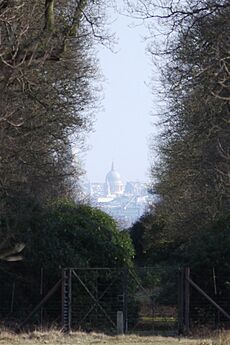
From King Henry's Mound, you can see a special protected view of St Paul's Cathedral over 10 miles (16 km) away! There's even a telescope to help you see it better. This view has been protected for centuries.
King Henry's Mound
King Henry's Mound might be a very old Neolithic burial mound. It's located in the gardens of Pembroke Lodge. There's a legend that King Henry VIII stood here to watch for a signal that Anne Boleyn had been executed.
From the west side of the mound, you can see a wide view of the Thames Valley. New gates called "The Way" were put up in 2012 to celebrate St Paul's 300th anniversary.
In 2016, a new tall building in Stratford, London, partly blocked the view of St Paul's from the mound. However, after campaigning by the Friends of Richmond Park, the Mayor of London has now made sure that new tall buildings won't block these important views.
Plants and Memorials
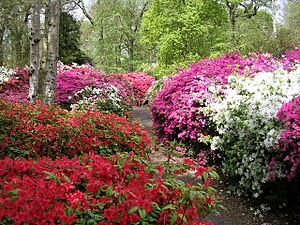
The park has open grassy slopes and woods with acid soils. The grasslands are kept healthy by deer grazing. There are many woods and small groups of trees, some planted with donations from the public.
The Isabella Plantation is a beautiful woodland garden that was created after World War II. It's fenced off to keep deer out. It opened to the public in 1953 and is famous for its colorful azaleas and camellias that bloom in April and May. It also has many rare trees and shrubs.
Other planted areas include:
- Jubilee Plantation: Created in 1887 for Queen Victoria's Golden Jubilee.
- Prince Charles' Spinney: Planted in 1951 with trees protected from deer.
- Teck Plantation: Established in 1905, named after the Duke and Duchess of Teck.
- Tercentenary Plantation: Planted in 1937 to mark 300 years since the park was enclosed.
- Victory Plantation: Established in 1946 to celebrate the end of World War II.
- Queen Mother's Copse: Created in 1980 for Queen Elizabeth The Queen Mother's 80th birthday.
- Two Storms Wood: Planted after two big storms in 1987 and 1990 destroyed many trees.
- Bone Copse: Started by the Bone family in 1988 to remember loved ones.
- Platinum Jubilee Woodland: Opened by Sir David Attenborough in 2023 to mark Queen Elizabeth II's Platinum Jubilee.
Poet's Corner and James Thomson
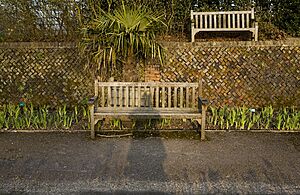
Poet's Corner is a special area in Pembroke Lodge Gardens that honors the poet James Thomson (1700–1748). He lived in Richmond. There's a curved metal bench here with lines from his poems.
In 2014, Poet's Corner was moved and updated with new benches made from reclaimed wood. These benches have a famous quote by Welsh poet W. H. Davies: "A poor life this, if, full of care, we have no time to stand and stare."
The John Beer Laburnum Arch connects Poet's Corner to King Henry's Mound. It's beautiful with yellow flowers in May.
Ian Dury's Musical Bench
In 2002, a "musical bench" was placed near Poet's Corner to remember rock singer Ian Dury (1942–2000). The bench has the words "Reasons to be cheerful" from one of his songs. After some vandalism, the bench was updated in 2015. Now, you can scan a QR code with your smartphone to listen to his songs and an interview!
Nature in the Park
Wildlife in Richmond Park
Richmond Park was first made for deer hunting. Today, about 630 red and fallow deer live freely in the park. To keep the deer population healthy, about 200 deer are culled each year in November and February. Sadly, some deer also die in road accidents or from eating litter.
The park is a safe home for many other animals, including woodpeckers, squirrels, rabbits, snakes, frogs, toads, and many different insects like stag beetles. It also has ancient trees and many types of fungi.
You'll also see a large number of ring-necked parakeets in the park. These birds came from ones that escaped or were set free from captivity.
-
A female ring-necked parakeet
Ponds and Streams
There are about 30 ponds in Richmond Park. Some were made to drain the land or provide water for animals. The Pen Ponds, which date from 1746, were once used to raise carp for food. They collect water from streams and release it into Beverley Brook.
Beverley Brook starts outside the park and flows through it near Robin Hood Gate. It's a great water source for deer and other animals. Its name comes from the European beavers that used to live in the river long ago.
Most streams in the park flow into Beverley Brook. However, a spring above Dann's Pond flows into Sudbrook. Sudbrook flows through a small valley and forms Ham Dip Pond and Ham Gate Pond, which were made for deer to drink from.
The Isabella Plantation has its own water system, with water pumped from the upper Pen Pond to Still Pond, Thomson's Pond, and Peg's Pond.
The newest pond in the park is Attenborough Pond, opened in 2014 by and named after the famous naturalist Sir David Attenborough. It was created as part of the park's conservation program.
Richmond Park in Culture
The Hearsum Collection
 |
|
| Formation | 2013 |
|---|---|
| Founder | Daniel Hearsum (1958–2021) |
| Registration no. | 1153010 |
| Legal status | Registered charity |
| Headquarters | Pembroke Lodge, Richmond Park |
| Location |
|
|
Chair
|
Jane Hearsum |
|
Budget
|
<£11,000 |
The Hearsum Collection is a charity that collects and saves items related to Richmond Park's history. It has over 5,000 items, including old prints, paintings, maps, and photos. Volunteers help organize everything. There are plans to build a new center so the public can easily see the collection.
In 2017, the Collection helped create an exhibition about the history of Richmond Park and other royal parks.
Richmond Park in Books
Fiction Books
- The Marquis of Lossie (1877) by George MacDonald has a chapter called "Richmond Park."
- In Georgette Heyer's Sylvester, or the Wicked Uncle (1957), characters visit Richmond Park.
- The Isabella Plantation is a setting in Chris Cleave's novel The Other Hand (2008).
- Richmond Park appears in Jacqueline Wilson's novel Lily Alone (2010).
- Novelist Shena Mackay wrote a short story about the park called The Running of the Deer (2009).
- Anthony Horowitz's novel Moriarty (2014) includes a scene in Richmond Park.
Non-fiction Books
- A Hind in Richmond Park (1922) by William Henry Hudson is an essay about his visits to the park.
Richmond Park in Art
Older Art (1600s-1800s)

- The Carlile Family with Sir Justinian Isham in Richmond Park was painted by Joan Carlile (1600–1679), who lived in Petersham Lodge.
- A portrait of John Lewis, the brewer who fought for public access to the park, was painted in 1758.
- Richmond Park by Thomas Rowlandson and Lovers in Richmond Park by James Smetham are held in the Yale Center for British Art.
- The Earl of Dysart's Family in Richmond Park by William Frederick Witherington is in The Hearsum Collection.
- Landscape: View in Richmond Park (1850) by John Martin is at the Fitzwilliam Museum.
- In Richmond Park (1852) by William Bennett is at Tate Britain.
- In Richmond Park (1856) by Henry Moore is in the York Museums Trust.
- Landscape with Deer, Richmond Park (1875) by Alfred Dawson is at the Reading Museum.
- White Lodge, Richmond Park (1898) by John Buxton Knight is in Leeds Museums and Galleries.
- View of Richmond Park, a Fountain on the Left and View in Richmond Park, A Small Bridge to the Right by Andrew Geddes are in Aberdeen Archives, Gallery and Museums.
Newer Art (1900s-2000s)
- Richmond Park (1913) by Arthur George Bell is at the London Transport Museum.
- Spencer Gore painted several landscapes of Richmond Park in 1913-1914, including Richmond Park and Wood in Richmond Park.
- Autumn, Richmond Park by Alfred James Munnings is at the Sir Alfred Munnings Art Museum.
- Chinese artist Chiang Yee included Deer in Richmond Park in his book The Silent Traveller in London (1938).
- Trees, Richmond Park, Surrey (1938) by Francis Ferdinand Maurice Cook is at the Manchester Art Gallery.
- Richmond Park No 2 by Laura Knight is at the Royal Academy of Arts.
- In Richmond Park (1962) by James Andrew Wykeham Simons is at University College London.
- Kenneth Armitage made sculptures and drawings of oak trees in Richmond Park between 1975 and 1986.
- Richmond Park Morning, London (2004) by Bob Rankin is at Queen Mary's Hospital, Roehampton.
Historic Posters
Many old posters promoting Richmond Park for travel were created by the Underground Electric Railways Company and London Transport. These include works by Charles Sharland, Alfred France, Arthur G Bell, Tony Sarg, Harold L Oakley, Edwin Noble, Emilio Camilio Leopoldo Tafani, Freda Lingstrom, Charles Paine, and Laura Knight. You can see many of these at the London Transport Museum.
Richmond Park in Films and TV
Richmond Park has been a filming location for many movies and TV shows:
- A train crashes into a tree in the film The Titfield Thunderbolt (1953).
- James Fox drives through the park in Performance (1968).
- The park was a backdrop for the historical film Anne of the Thousand Days (1969), about King Henry VIII.
- An Indian dust storm was filmed here for Heat and Dust (1983).
- The Royal Ballet School in the park was featured in Billy Elliot (2000).
- Director Guy Ritchie filmed parts of Sherlock Holmes: A Game of Shadows (2011) in the park.
- Scenes from the Disney fantasy film Into the Woods (2014) were filmed here.
- The family comedy film Patrick (2018) also used the park as a setting.
Richmond Park also appears in TV shows like Blue Peter, Inside Out, and Springwatch. A nature documentary called Richmond Park – National Nature Reserve, presented by Sir David Attenborough, won an award in 2018.
International Connections
Richmond Park in Brunswick, Germany
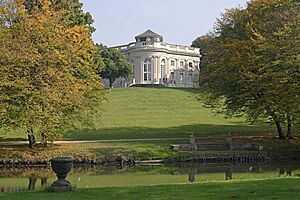
There's another "Richmond Park" in Brunswick, Germany! It was created in 1768 for Princess Augusta, who was King George III's sister. She was feeling homesick, so an English-style park and a palace were designed for her, both named "Richmond."
The city of Braunschweig bought the palace and park in 1935. The park has been open to the public since 1964.
See also
 In Spanish: Parque de Richmond para niños
In Spanish: Parque de Richmond para niños


